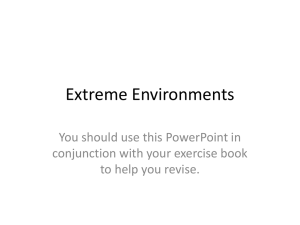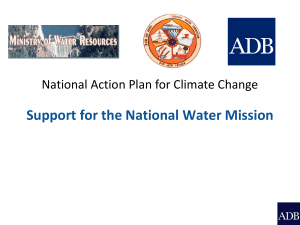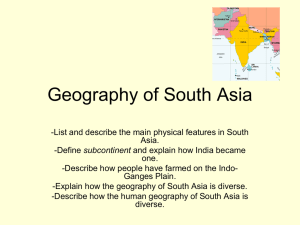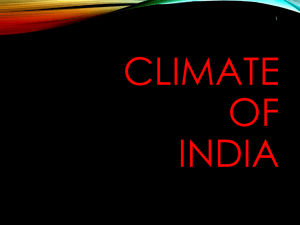File - gurudeva.com
advertisement
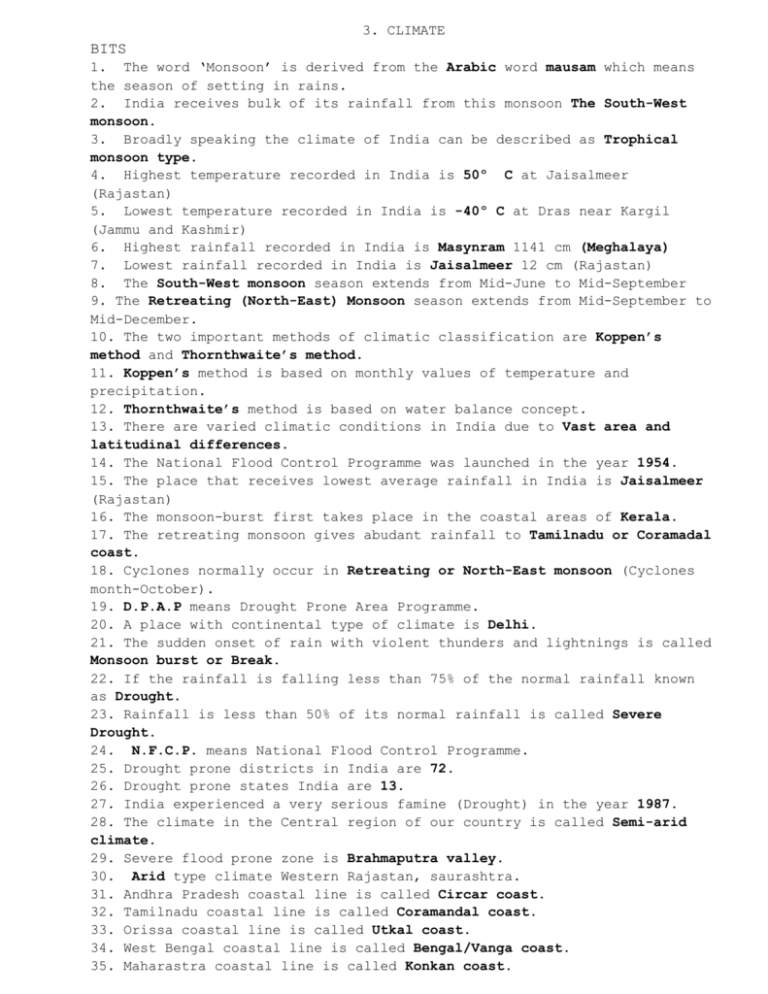
3. CLIMATE BITS 1. The word ‘Monsoon’ is derived from the Arabic word mausam which means the season of setting in rains. 2. India receives bulk of its rainfall from this monsoon The South-West monsoon. 3. Broadly speaking the climate of India can be described as Trophical monsoon type. 4. Highest temperature recorded in India is 50º C at Jaisalmeer (Rajastan) 5. Lowest temperature recorded in India is -40º C at Dras near Kargil (Jammu and Kashmir) 6. Highest rainfall recorded in India is Masynram 1141 cm (Meghalaya) 7. Lowest rainfall recorded in India is Jaisalmeer 12 cm (Rajastan) 8. The South-West monsoon season extends from Mid-June to Mid-September 9. The Retreating (North-East) Monsoon season extends from Mid-September to Mid-December. 10. The two important methods of climatic classification are Koppen’s method and Thornthwaite’s method. 11. Koppen’s method is based on monthly values of temperature and precipitation. 12. Thornthwaite’s method is based on water balance concept. 13. There are varied climatic conditions in India due to Vast area and latitudinal differences. 14. The National Flood Control Programme was launched in the year 1954. 15. The place that receives lowest average rainfall in India is Jaisalmeer (Rajastan) 16. The monsoon-burst first takes place in the coastal areas of Kerala. 17. The retreating monsoon gives abudant rainfall to Tamilnadu or Coramadal coast. 18. Cyclones normally occur in Retreating or North-East monsoon (Cyclones month-October). 19. D.P.A.P means Drought Prone Area Programme. 20. A place with continental type of climate is Delhi. 21. The sudden onset of rain with violent thunders and lightnings is called Monsoon burst or Break. 22. If the rainfall is falling less than 75% of the normal rainfall known as Drought. 23. Rainfall is less than 50% of its normal rainfall is called Severe Drought. 24. N.F.C.P. means National Flood Control Programme. 25. Drought prone districts in India are 72. 26. Drought prone states India are 13. 27. India experienced a very serious famine (Drought) in the year 1987. 28. The climate in the Central region of our country is called Semi-arid climate. 29. Severe flood prone zone is Brahmaputra valley. 30. Arid type climate Western Rajastan, saurashtra. 31. Andhra Pradesh coastal line is called Circar coast. 32. Tamilnadu coastal line is called Coramandal coast. 33. Orissa coastal line is called Utkal coast. 34. West Bengal coastal line is called Bengal/Vanga coast. 35. Maharastra coastal line is called Konkan coast. 36. Karnataka coastal line is called Kanara coast. 37. Kerala coastal line is called Malabar coast. 38. The interior parts of the country experience extreme weather conditions known as “Continental climate”. 39. Rajastan, Andhra Pradesh, Bihar, Maharastra, Madhya Pradesh, Orissa are the most drought affected states in India. Question and Answers 1. What is Monsoon? 1. Originally, the word ‘monsoon’ is referred to the blowing of winds which reverse seasonally between the Indian sub- continent and the Indian Ocean. 2. The word ‘monsoon’ is dereved from the Arabic word ‘mausam’ which means the season of setting in rains. 3. There are two types of monsoons in India. I. The South-West monsoon. II. The North-East monsoon. 2. What is meant by monsoon burst of break? A. The sudden onset of rain with violent thunders and lightnings is called Monsoon burst or Break. 3. Difine “Drought”? A. A condition when the rainfall is lessthan 75 percent of the normal is called drought. 4. Difine “Severe Drought”? A. A condition when the rainfall is lessthan 50 percent of the normal is called severe drought. 5. Mention the causes of drought. 1. Inadequacy of rainfall. 2. Deficiency of soil moisture. 3. High temperature. 6. How many seasons the Indian weather conditions are divided? What are they? A. 1. 2. 3. 4. Four seasons are recognised in India. They are The Summer season : March to June. The South-West monsoon season : June to September. The North-East monsoon season : September to December. The Winter season : December to March. 7. What are the highest and lowest temperatures recorded in India and where? A. 1. Highest temperature recorded in India is 50º C at Jaisalmeer (Rajastan) 2. Lowest temperature recorded in India is -40º C at Dras near Kargil (Jammu and Kashmir) 8. What are the two important methods of climate classification? A. The two important methods of climatic classification are Coppen’s method and Thornthwaite’s method. 1. Koppen’s method is based on monthly values of temperature and precipitation. 2. Thornthwaite’s method is based on water balance concept. 9. Why is Indian agriculture called a gamble in the Monsoon? 1. Agriculture in India depends on monsoon rains. 2. These rains are uncertain. 3. Extreme amounts of rainfall give rise to floods. 4. monsoon hamper our agricultural development. 5. Low rainfall leads to droughts. 6. These calamities have an adverse effect on the economic development of India. 7. Thus Indian agriculture is referred to as a gamble in the monsoons.





